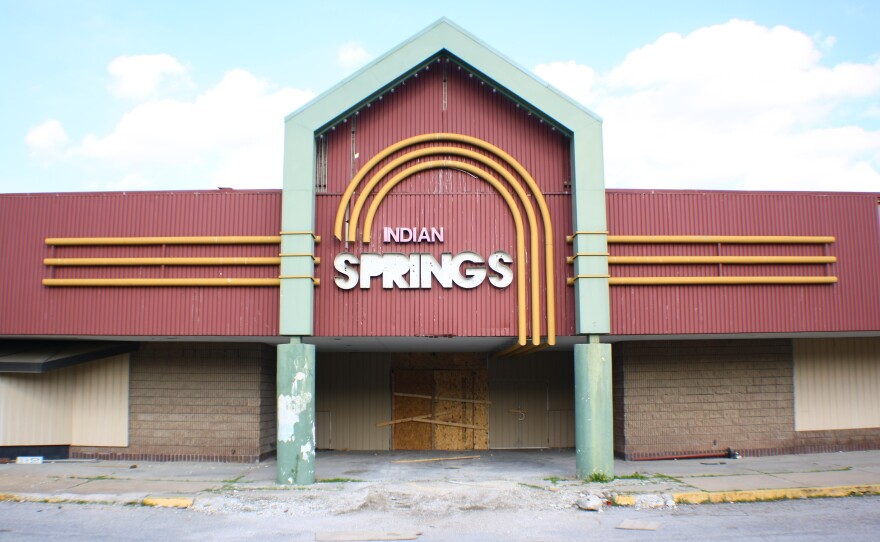Metcalf South and Indian Springs were built when indoor shopping malls were cropping up all over the United States. Both rose to prominence and became destinations during the same time period of the late 1970s and early '80s. But they declined for very different reasons, which reverberate in the aftermath and redevelopment of their spaces.
Metcalf South was one of Kansas City's first in the indoor shopping mall wave. It opened in 1967, with a ribbon cutting ceremony accompanied by Tony DiPardo’s Zing Band. Indian Springs opened at the tail end of the trend in 1971 and was one of the largest indoor malls in the Midwest. Built along the freshly paved I-635 to the airport, its opening boasted a series of events, including “Kansas and Missouri Miss USA preliminaries, boat shows, pet shows, fashion shows, world trade shows, art fairs, truck shows," according to the Kansas City Star.
They were part of a local and national trend for enclosed, all encompassing shopping experiences developed in response to the new suburban, automobile-dependent landscapes of U.S. cities. Malls are also at least partly responsible for the death of downtown shopping in Kansas City. Indian Springs opened while downtown Kansas City, Kansas was being remodeled.
Jacob Wagner, director of urban studies at University of Missouri Kansas City, says Indian Springs was the nail in the coffin of downtown KCK.
“Many blame the remodeling project for the decline of downtown,” says Wagner. “But the retail moved to Indian Springs and stayed there.”
Retail sales at both centers grew dramatically throughout the 1970s. Michael Frisch, professor of architecture, urban planning and design at UMKC, analyzed government data on retail centers in the Kansas City metro. In 1972, the top retail centers were downtown Kansas City, Country Club Plaza and Metcalf South.
By 1977, Metcalf South had moved to number one. Indian Springs had doubled its sales dollars and was eighth in the Metro.
But Gary Mayerle, architect at Boyle and Mayerle, says too many shopping centers were built for the amount of retail dollars being spent in Kansas City. The malls also carried the same national retailers.
“Did every mall that got built really need to have a Spencer’s Gifts?” he says.
Metcalf South and Indian Springs did stand out in a number of ways. Metcalf South had its signature fountain that flowed down three floors. But because it was built during the early years of indoor malls, it was also the smallest with only two anchor stores.
In 1991, Oak Park Mall, about a 10 minute drive from Metcalf South, expanded to its current size of 1.5 million square feet with four anchor stores. Through the 1990s Metcalf South gradually saw its stores closing and customers dwindling.
Daniel Serda, owner of urban planning and economic firm Insite LLC and lifelong KCK resident, remembers Indian Springs had a maze for children to explore and around Christmas time, a talking Christmas tree.
“You’re walking by the tree and the tree would start talking to you. ‘Hi, how are you? What do you want for Christmas?’” says Serda. “It was kind of creepy.”
Serda spent his childhood and pre-teen years wandering around Indian Springs with and without his parents. But when he got into high school, he noticed a shift: more young African Americans were hanging out at the mall and the security guards had become more aggressive.
“There were any number of times where walking along, right behind you, there’d be these security guards,” says Serda. “I remember once turning around and saying ‘Are you following us?’ Because it seemed that way. And they would get very defensive and say ‘Why? Should I be following you?’ I had never experienced anything like that.”
On a Saturday night in 1989, 18-year-old Patrick Sills hit and broke the screen to the game “The Empire Strikes Back” at the Fun Factory video game arcade in Indian Springs. He was chased by a security guard into the parking lot, where the guard opened fire and killed him. It was on the front page of the Kansas City Star on Monday morning.
“And I remember my dad said ‘You’re not going there again,’ says Serda. “And I said, ‘I don’t want to.’”
Shoppers from other metro areas stopped going to Indian Springs and the local population wasn’t enough to sustain the mall. By the late nineties, proposals were popping up for what could be done with the space, including an aquarium or community center.
In 2007 the Unified Government bought the malland in 2014, they hired Lane4 Property Group to act as a broker for the space and to develop a proposal for the site.
Lane4 and The Kroenke Group bought Metcalf Southand the 95West Shopping Center in February 2014. Less than a year later, they released conceptual plans and set dates for community meetings so they could introduce the proposal, which is mixed-use retail, entertainment and housing, to the public.
Crews are removing asbestos from Indian Springs, but as of yet, there are no proposals for the site.
This look at the line between Wyandotte and Johnson Counties is part of KCUR's months-long examination of how geographic borders affect our daily lives in Kansas City. KCUR will go Beyond Our Borders and spark a community conversation through social outreach and innovative journalism.
We will share the history of these lines, how the borders affect the current Kansas City experience and what’s being done to bridge or dissolve them. Become a source for KCUR as we investigate Johnson and Wyandotte Counties.








